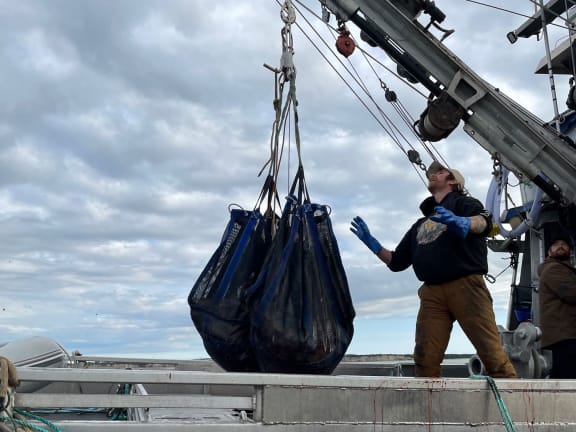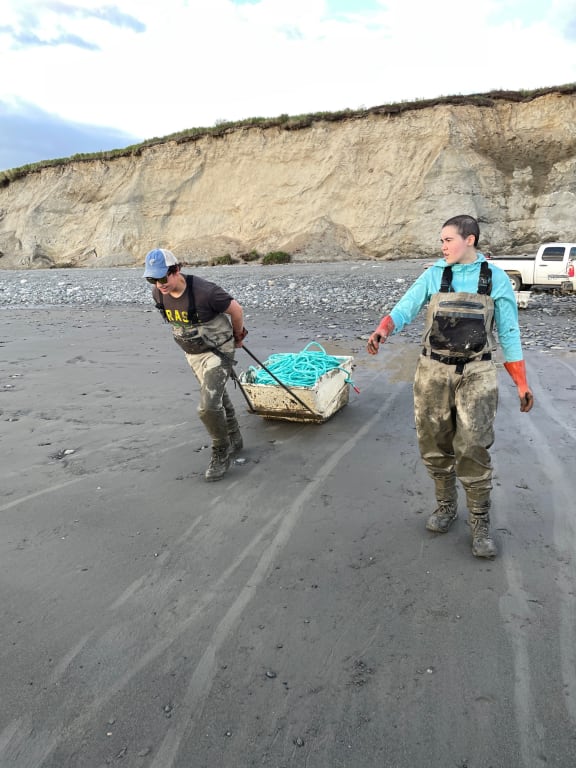With set netting, the sun marks the season of abundance; the moon dictates when you can partake in the harvest.
There are various methods for harvesting salmon, each requiring a different type of gear, a different set of resources, and specialized skills. This week, as a glimpse into one of these methods, we’re sharing a day in the life of Kallenberg family friend and commercial fisherman Melanie Brown, via her day’s log from July 1. Melanie and her crew harvest sockeye in Bristol Bay with set nets.
As a bit of background, set netting is a tradition of harvesting salmon passively, close to the shore, with a carefully anchored net. But the practice of set netting is anything but passive — as you read Melanie’s log, I hope you’ll begin to understand that this harvest is a carefully choreographed dance of labor that’s sustained over the course of a salmon run, a cyclical practice that’s cued by the ebb and flow of the tides.
–
The Push: A Day in the Life of a Bristol Bay Set Netter
By Melanie Brown
By the time July 1st rolls around, Bristol Bay sockeye salmon season is in full swing. I’m a Naknek River District set netter, and my crew and I live our lives by the tides during the season. Our schedule is made of days that are divided into roughly six-hour time frames to pick when the AM tide is flooding, rest if the fish aren’t running hard, and then go to pick the ebb tide until the water is out and then do it again for the PM tide.
Here is a typical day in our lives:
July 1st, 2024
-
5:28 am Wake up, make coffee, eat a bite of food. Layer clothing for the weather and dress out in gear shed. Waders, wading shoes, gloves, raingear. Make sure waterproof bucket has water, snacks, tide book and extra layers of dry clothing. Check oil in the outboard motor and gas in tank.

The tide becomes the clock, and the tide book the guidebook during the season.
-
5:58 am Load up and roll out with skiff in tow.
-
6:08 am Arrive at beach and back skiff into water to launch. Park truck and trailer high enough on the beach so the incoming tide does not reach it.
-
6:13 am Run to site
-
6:18 am Get under the anchor line and tie end of net tail onto the line. Wait for regulation opening time.
-
6:30 am Time for regulation opening. Throw the ring for the lead line over the gunwale of the skiff and start pulling skiff toward the shore hand over hand with the line as the net feeds out of the trailing side tying net as we go. Even though the water is at its low, there should be plenty of tide to lay out completely because there was a 4-foot hold up tide to start with.
-
6:40 am The net should be set by now and pause to look back at the gear to see if the salmon are striking. Let the net soak for a bit to give the water time to cover the net with more tide.
-
6:55 am Lower the motor and run to the other end of the net to pull through the gear from that side so you don’t have to pull against the incoming tide.

The crew pulling through the gear.
-
7:00 am Pull through the gear with one crew member pulling the cork line side of the net and the other two crew members pull the leads through the boat. As salmon come over the side of the boat, pick them out and place them in the brailer bags that are hanging in the bow and stern of the boat.
-
7:30 am Pull through the net again to see if the fish are still striking or if there was only an initial push of fish with the incoming tide.
-
8:00 am Motor to the tender to deliver fish.
-
8:05 am Tie up to the tender and prepare bags for lifting out of the skiff to be weighed. Give permit card to bookkeeper so they can enter it into fish ticket system along with your fish weight.

To be weighed: A brailer bag, heavy with salmon.
-
8:10 am Wash skiff down with hose from tender. Hang bags over the side to wash slime and blood off them as skiff runs. Sign fish ticket and untie from tender.
-
8:15 am Run back toward the mouth of the river while rinsing bags and pull the plugs to drain slimy and bloody water from the skiff.
-
8:20 am Trailer skiff and head home to rest
-
8:30 am Stop at processor camp to use firehose to rinse salt water off of wheel hubs on truck and trailer
-
8:40 am Drive home to hang gear in shed, go inside and rest
-
12:23 pm Wake up, have a snack and gear up to pick the ebb tide fish.

Sometimes snacktime is salmon. Sometimes it’s a gluten-free oat bar with black coffee.
-
12:53 pm Roll out
-
1:03 pm Launch skiff and motor out to fishing site
-
1:13 pm Get under the gear, pull through the net and pick fish. Deliver to the tender when the bags are full or if the fish slow down. Go back to the net after delivery and wait for the tide to drop.
-
4:00 pm The water should be low enough to leave the net. Go to tender, deliver fish and head home to rest.
If the regulation opening continues, we don’t have to pull our gear in and we will head out again for the PM tide with much of the same timing as the morning, but without the part that pertains to setting the gear again.
-
7:30 pm Wake up, eat and gear up for the pick on the flood of the tide.
-
8:00 pm Roll out
-
8:10 pm Launch and motor to site
-
8:20 pm Pull and pick through gear. After picking gear once, check again to see if the fish are still striking. If the fish have slowed down, deliver them to the tender and go home to rest. If the fish keep hitting, stay on the gear and keep clearing it.
This timing pattern continues throughout the season, and the tide table creeps forward, roughly one hour each day along with the timing of the tide. Sometimes when we are waiting for the tide to drop, we have time to visit friends and family at neighboring sites. I like to keep my backpacker guitar on board for when we have downtime on the water. Also, when the fishing is slow enough, that is when I have time to take off my gloves and pull my phone out of its dry bag to take pictures of the beauty around us — unless the wind and waves make the water too rough.

A view of the mud, when the tide is low.
When we go out on the night tides and it is dark, we have to remember our headlamps and shine a spotlight while we are running to look for gear in the water and other hazards that could wind up in our motor propeller. This is also so that we can be seen by other boats that are running.
When the fishing is heavy, we don’t have time to go home to rest. Instead, we keep clearing the gear until the bags are full and go back to the net to clear it some more. This continues until the tide has receded and the net is dry. If we really get behind on our sleep and hear that the fish are not running very hard, we sometimes skip the flood pick so that we can rest up — although, it is hard to predict when the sockeye run will peak in Bristol Bay, so we always have to be ready to push hard when the fish come rolling in.

A portrait of the crew.
–
The tides have shifted since Melanie recorded this log of her day. A look at the tide book reveals that by today, she and her crew will be harvesting salmon beneath the blazing afternoon sun, and again in the soft darkness of Alaskan night.
Live Wild,
Monica
Pictured above: Melanie’s crew — her children Mari and Oliver — pulling a line out to stretch from anchor to anchor. This is what the gear is tied to when fishing is open.






